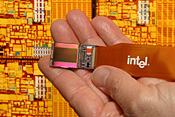This new technology, code-names Cayley, is based on the LCOS (Liquid Crystal on Silicon) technique which is used to create small chips, called microdisplays that produce images that are displayed on big screen, rear projection TVs.
| LCOS technology sandwiches a layer of liquid crystal between a cover glass and a highly reflective, mirror-like surface patterned with pixels that sits on top of a silicon chip. These layers form a microdisplay that can be used in projection displays such as large-screen, rear-projection TVs. Intel's Cayley LCOS technology uses Intel's advanced silicon manufacturing processes to produce a high-quality surface for reflecting light which creates an extremely bright display.
Intel has developed a unique fabrication process for LCOS microdisplays that enables them to track to Moore's Law - the theorem first outlined by Intel co-founder Gordon Moore that states that the number of transistors on a chip roughly doubles every two years, resulting in more features, increased performance and decreased cost per transistor. By increasing the transistor count on the silicon used in the LCOS microdisplay, Intel chip designers can integrate additional functionality to improve display performance such as brightness and image quality. Intel's Cayley LCOS technology is based on an all digital design that produces a sharper, more precise image than other architectures based on analog technology. Another key aspect of the LCOS technology is that it enables the creation of multiple microdisplays with increasing levels of resolution without changing size of the microdisplay. The consistent and compatible display area of microdisplays based on Intel's LCOS technology will enable OEMs to re-use light engine designs for a wide array of products in various screen sizes and resolutions, thus reducing their development costs. |
 |
Intel plans to deliver Cayley-based microdisplays in the second half of this year. A few OEMs and HDTV manufacturers like InFocus, TCL, Skyworth and Primax are developing products at this moment based on these new Cayley microdisplays from Intel.